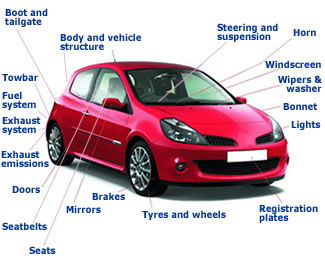
Check your vehicles MOT status and history online from here.
If your vehicle is 3 years old or more you are required by law to have an annual safety check, the Ministry of Transport test, commonly known as the MOT test. The purpose of the MOT test is to ensure the vehicle meets the minimum safety level required by law. It is a regulated inspection of over 150 safety-related and emission checks at a standard charge of £54.85 (no VAT is applicable)
MOT Test Check List
Bonnet Catch
Brakes
Doors
Exhaust and emissions
Fuel system
Horn
Lights
Mirrors
Number plate and VIN
Seat belts
Seats
Steering
Suspension
Vehicle structure
Wheels and tyres
Windscreen
Wipers and washer fluid
The MOT Certificate
The MOT certificate confirms that at the time of the test, without dismantling it, the vehicle met the minimum acceptable environmental and road safety standards required by law. It doesn’t mean that the vehicle is roadworthy for the length of time the certificate is valid. The MOT certificate is also no guarantee of the general mechanical condition of your vehicle. The test doesn’t cover the condition of the engine, clutch or gearbox.
What the MOT Test Includes
The MOT looks at some important items on your car to see that they meet key legal requirements at the time of test.
The body and vehicle structure
Is free from excessive corrosion or damage in specific areas and there are no sharp edges likely to cause injury.
The Fuel System
Has no leaks and the fuel cap fastens and seals securely. The fuel cap will need to be opened so be sure the key is available.
The exhaust emissions
The vehicle meets the requirements for exhaust emissions, dependant on the age and fuel type of the vehicle.
The exhaust system
Is secure, complete, without serious leaks and silences effectively.
The seat belts
All belts installed are checked for type, condition, operation and security. All compulsory seat belts must be in place.
The seats
The front seats are secure. Front and rear backseats can be secured in the upright position. Components to be inspected.
The doors
Latch securely in closed position. Front doors should open from inside and outside the vehicle. Rear doors may need to be opened to gain access to testable items.
The mirrors
The minimum numbers are on the vehicle, their condition and security.
Load security
Boot or tailgate can be secured in the closed position.
The brakes
Their condition, operation and performance (efficiency test). Note the removal of the road wheels is not part of the test.
The tyres and wheels
Their condition, security, size, type and tread depth. Spare tyres are not inspected.
The registration plates
Their condition, security, characters correctly formed and spaced.
The lights
Their condition, operation and security. Headlamps for aim.
The bonnet
Securely latches in the closed position.
The wipers and washers
Operate to give the driver a clear view ahead.
The windscreen
Its condition and the driver’s view of the road.
The horn
Operates correctly and is of a suitable type.
The steering and suspension
Are of a satisfactory condition and operation.
The vehicle identification number (VIN)
Is on vehicles first used on or after 1 August 1980. Not more than one different VIN is displayed except on multistage build vehicles.
